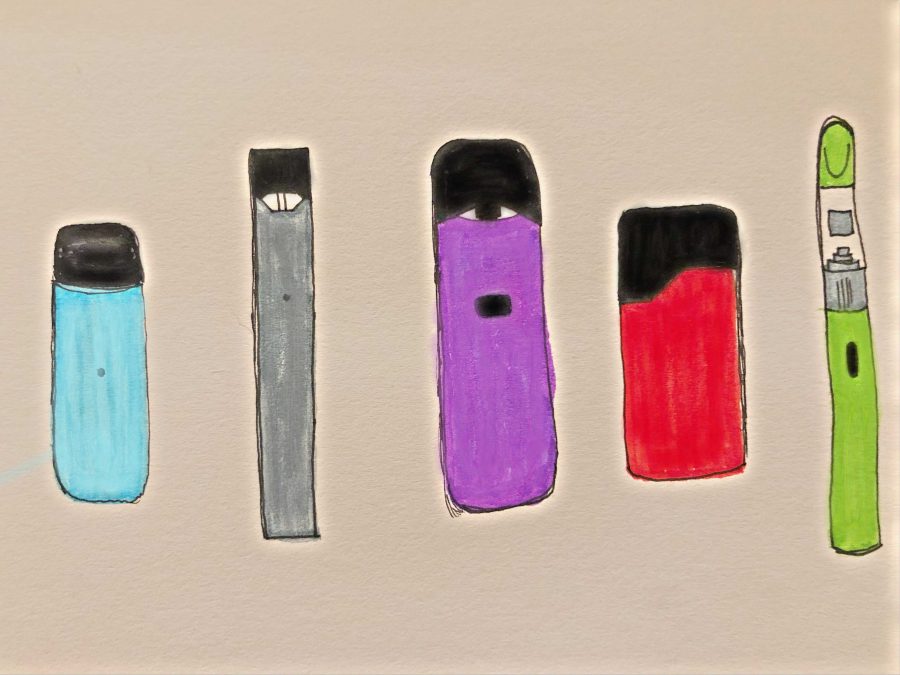Sourins, Juuls, Novos, Nords, Puff Bars, even wax pens, you probably know them well, or at least you think you do…
Almost every YouTube video you click on provides a public service announcement from the Food and Drug Administration’s Real Cost campaign, claiming that “there’s an epidemic spreading,” putting “acrolein,” into your lungs. You may well know the words by heart at this point, but chances are, they don’t really mean much to you if you are a teenager who participates in this new millennial fad.
The reality is, the long term effects of vaping are only now becoming apparent. When many teens started vaping, the ‘real cost’ wasn’t widely advertised or even known, it was only implied that vaping was somehow healthier than smoking cigarettes. Also, teens were drawn to the colors of the small discrete contraptions and the hundreds of flavors. But the unfortunate reality is, most teens who vape would likely never have taken up nicotine ingestion in the first place, had it not been for these attractive new devices. A 2013-2014 survey from the Food and Drug Administration showed that “81 percent of current youth e-cigarette users cited the availability of appealing flavors as the primary reason for use.”
VHS chemistry teacher Karen Reynosa had a lot to say on the topic: “I think everybody has this piece inside of them that they want to explore new things, and I feel like some people climb a mountain and some people are athletic, and some people smoke things, and it’s just one of those things that people are trying because it’s new and it’s different, and it seems fun, and the flavors are unusual, and I don’t think that there’s this tremendous connect with ‘if I do this, then what does that mean?’”
The number of high school students who vape is rapidly growing. According to the U.S. Center for Disease Control and Prevention, in 2018, 20.8 percent of high school students–over three million teenagers–were recorded as students who have vaped or vape currently. Vaping seems to be growing in popularity at VHS also: “Most people in this school [vape]. You can’t walk into a bathroom without smelling weed or something, like cotton candy flavor…it’s pretty addictive. I’ve seen so many people that…can’t go a day without hitting it. It’s like it’s taken over kids,” says senior Talia Walsh.

First and foremost, nicotine is an addictive chemical, most people know this. But why are so many teens, who would likely never have smoked in the first place, suddenly so dangerously dependent on it?
Sophomore Joseph Lombardo says, “Peer pressure in social situations with people vaping…I think that is an issue that I’ve seen arise a lot when I’m out with friends. People will be passing [it] around…they’re like ‘dude come on it’s just one time,’” and so it begins.

However, peer pressure is not the only reason. The sleek, eye-catching appearance of vape devices causes many to wonder who they are really for–teens or adults. It used to be that if a student wanted to smoke marijuana at school, they had to bring actual marijuana–much riskier as the very recognizable scent would follow the smoker for the rest of the day. Now, marijuana is smoked out of a small pen shaped contraption, producing minimal smoke and minimal smell; it fits in your pocket, and it’s rechargeable. With nicotine devices, it’s similar; they don’t smell like cigarettes, they smell like pink lemonade and cherry vanilla, they’re green, pink, red, yellow, rainbow, and students even have fun putting stickers on them. How tempting and irresistible–for teenagers.
It is the FDA’s responsibility to determine the safety of American sold food and drugs, and they legalized vaping devices for people over the age of 18. But why did the FDA legalize such a harmful product that is used more often by teenagers than by its supposed ‘target audience’?
That’s right, while about 20.8 percent of high school students vape, only about 3.7 percent of adults use the same e-cigarettes, according to the CDC.
Also, vape devices have the same, if not worse chemicals than regular cigarettes, some of which may include benzene (found in gasoline), beryllium (found in nuclear weapons), cadmium (found in batteries), carbon monoxide (found in car exhaust), formaldehyde (found in embalming fluid), lead, nickel, shall I go on?
Not to mention that the amount of nicotine in a vape may be much higher than that in a cigarette. Teenagers, who often opt for 50-55 milligrams of “nic” (nicotine doses range from 0-55 mg) and use it multiple times a day, are actually putting far more nicotine into their bodies than a cigarettes would. Cigarettes contain around 15 milligrams of nicotine.
So what does this mean for VHS?
Vice principal Charles Cornwell explained his plan to move forward. “Confiscation [is]…part of the circle of rehabilitation. What we do at the school here, you know, not only do we confiscate it but we do mandatory counseling to go with that, because we want kids to realize that what they’re doing has some long term effects.”

However, the biggest change will be the new vape detectors that will be installed in every bathroom: “We did find a company in New York that’s going to sell us some detectors; they will detect vape, [which] will automatically let us know via our phone that there’s something going on in there,” Cornwell explained.
For some, this may be a deterrent, but many students will bypass this system by “ghosting,” where the smoke is briefly let out and then quickly sucked back in until it evaporates, or “zeroing,” where smoke is sucked in and held until it evaporates.
“I’m not the kind of guy that’s looking to catch you and bust you,” assured Cornwell, “I want to be proactive. I want to teach you ahead of time…the last thing I want to do is more paperwork.”















